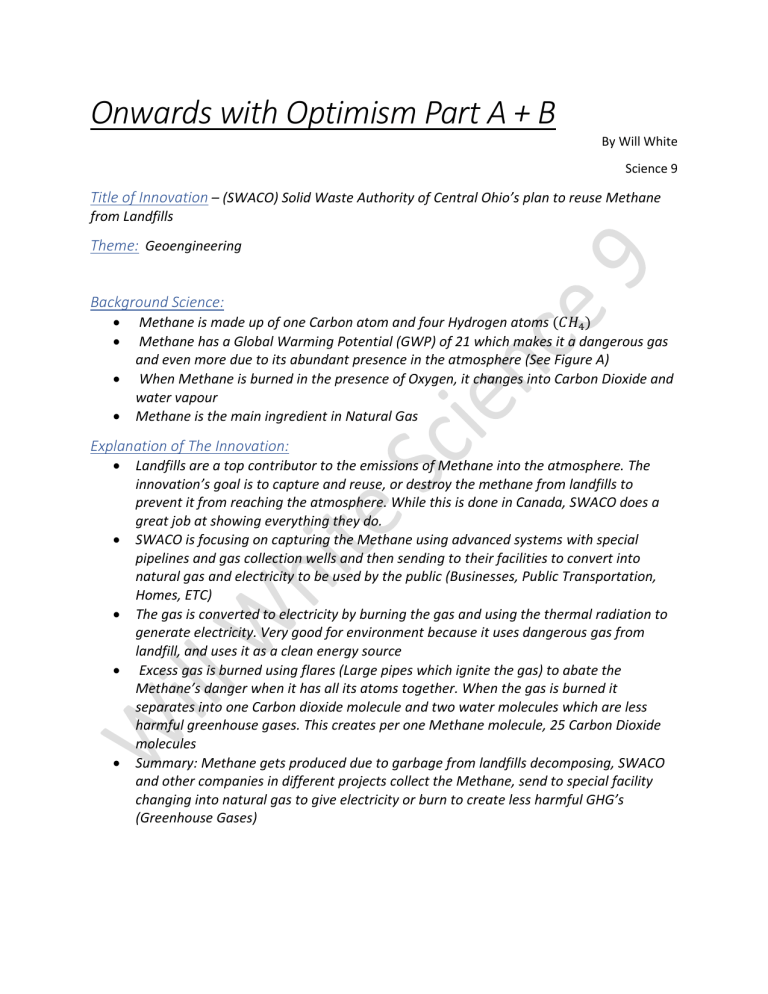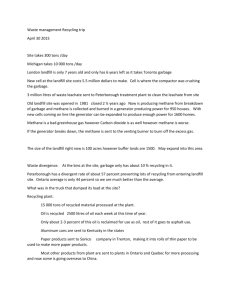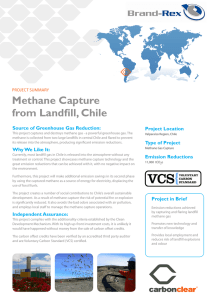
Onwards with Optimism Part A + B By Will White Science 9 Title of Innovation – (SWACO) Solid Waste Authority of Central Ohio’s plan to reuse Methane from Landfills Theme: Geoengineering Background Science: Methane is made up of one Carbon atom and four Hydrogen atoms (𝐶𝐻4 ) Methane has a Global Warming Potential (GWP) of 21 which makes it a dangerous gas and even more due to its abundant presence in the atmosphere (See Figure A) When Methane is burned in the presence of Oxygen, it changes into Carbon Dioxide and water vapour Methane is the main ingredient in Natural Gas Explanation of The Innovation: Landfills are a top contributor to the emissions of Methane into the atmosphere. The innovation’s goal is to capture and reuse, or destroy the methane from landfills to prevent it from reaching the atmosphere. While this is done in Canada, SWACO does a great job at showing everything they do. SWACO is focusing on capturing the Methane using advanced systems with special pipelines and gas collection wells and then sending to their facilities to convert into natural gas and electricity to be used by the public (Businesses, Public Transportation, Homes, ETC) The gas is converted to electricity by burning the gas and using the thermal radiation to generate electricity. Very good for environment because it uses dangerous gas from landfill, and uses it as a clean energy source Excess gas is burned using flares (Large pipes which ignite the gas) to abate the Methane’s danger when it has all its atoms together. When the gas is burned it separates into one Carbon dioxide molecule and two water molecules which are less harmful greenhouse gases. This creates per one Methane molecule, 25 Carbon Dioxide molecules Summary: Methane gets produced due to garbage from landfills decomposing, SWACO and other companies in different projects collect the Methane, send to special facility changing into natural gas to give electricity or burn to create less harmful GHG’s (Greenhouse Gases) Figure B Figure A Corroborated Information: Disputed ground: The future of landfill gas-to-energy – Wastedive The article gave a very strong breakdown and introduction into the innovation, Landfill Methane Capture. It also talked about concerns risen by organizations and companies as well as what those and other companies are doing. For example, groups like Sierra Club, who are referenced voice their concerns over how “Landfill gas capture systems are not effective at mitigating net emissions, because any escaped methane poses a risk.” Detailed inside it talks more about the operational use of the facilities, such as how they are very effective as a cheaper system compared to anaerobic digesters. According to LMOP referenced here, using this system 1 million tonnes of municipal waste can create 0.78 MW of electricity which is a lot of electricity. Lastly, another favourited factor of landfill gas that encourages operators is the large economic benefit through carbon credits and selling the electricity. Reaction To The Innovation: From CBC News – I give this article two thumbs up. I thought it gave a very advanced and well researched breakdown in such a short space. I felt that this overall was a high tier article due to the fact it was able to squeeze a large complicated topic into a compact bundle of scientific joy. I also enjoyed more specifically how they expressed exactly how much energy the company was producing in terms of smartphones charged, because this felt like I could truly understand how much they were making. CBC also, to my impression made a very scientifically oriented article that is still digestible to people who are not familiar to the innovation in question. Overall, this article gets my full support because it beautifully summarized the innovation, landfill methane capture whilst also making it easily understandable to a non scientifically experienced reader. Provocative Quotes: "Landfills are the third-largest source of methane emissions, so they're really a big source of climate pollution," - Peter Zalzal Landfills generate methane as organic waste decomposes. Rather than getting released as emissions, that methane can be captured and used to produce electricity. – Project Drawdown Honest Reflection with Personal Connection: This project has instilled in me a deeper understanding of how even terrible things can help so much. Before this project, I never thought landfills could be such a gold mine and thought they were just a carbon source with no mean of helping humanity. But I was really enlightened and very interested in this interesting new way of producing electricity when I discovered it. I will admit however, this project did bore and infuriate me at sometimes due largely to a seeming lack of information regarding this innovation however it ended out all right by the end. Also, shifting my view, I think it is very impressive what SWACO is doing, because I never really imagined that this would be an innovation used by governments when I first found it as I pictured it to be more corporation and money earning oriented. I connected to this project because I always wondered what really happens to all the garbage that goes into landfills. My family is very passionate about recycling and reusing which is why I have been influenced this way. Before the COVID-19 pandemic, I used to wander the streets of downtown Vancouver and see garbage bins overflowing with waste, put out by humans. I was heartbroken to think about where it goes and who it will inevitably harm. But now that I have done this project, I can rest slightly easier to know that this waste is being recycled and put into homes as electricity through projects done in Vancouver like SWACO’s. All in all, my connection to this project was the reason for this innovations invention, the garbage, and how it makes me feel safer to know that this carbon source is at least being reused than just left to pollute. Sources Cited: “Overview of Greenhouse Gases.” EPA, Environmental Protection Agency, 28 May 2020, www.epa.gov/ghgemissions/overview-greenhouse-gases. “Basic Information about Landfill Gas.” EPA, Environmental Protection Agency, 4 May 2020, www.epa.gov/lmop/basic-information-about-landfill-gas. “Methane Capture and Use.” EPA, Environmental Protection Agency, archive.epa.gov/climatechange/kids/solutions/technologies/methane.html. “Landfill Methane Capture @ProjectDrawdown #ClimateSolutions.” Project Drawdown, 1 Mar. 2020, drawdown.org/solutions/landfill-methane-capture. Harding, Tom. “CC_Greenhouse Effect (3).” Google Slides, Google, docs.google.com/presentation/d/1Vvrx7gHUPjS_MFpjl_fF6m6gopf3icoyOj_jRHRUT0w/ edit#slide=id.g7e7abb6914_0_0. “Gas-to-Energy Project: SWACO, OH.” Gas-to-Energy Project | SWACO, OH, www.swaco.org/284/Gas-to-Energy-Project. Harding, Tom. “CC-SSS-9.” Google Docs, Google, docs.google.com/document/d/1V6Rtj7vuXinhdXoSYTKKRix8U52FJO9xWk77QMIvLQ/edit. Witynski, Max. “Disputed Ground: The Future of Landfill Gas-to-Energy.” Waste Dive, 12 July 2019, www.wastedive.com/news/disputed-ground-the-future-of-landfill-gas-toenergy/557706/. Gustin, Georgina, et al. “Trump EPA Gives Landfills a Pass on Climate-Warming Methane.” InsideClimate News, 10 Apr. 2018, insideclimatenews.org/news/23052017/methane-rulestrump-epa-obama-clean-power-plan-waste-management-delay. “Landfill Hits Milestone Capturing Methane from Garbage to Produce Power | CBC News.” CBCnews, CBC/Radio Canada, 13 Mar. 2019, www.cbc.ca/news/canada/newbrunswick/eco360-methane-burning-generator-1.5054217.





